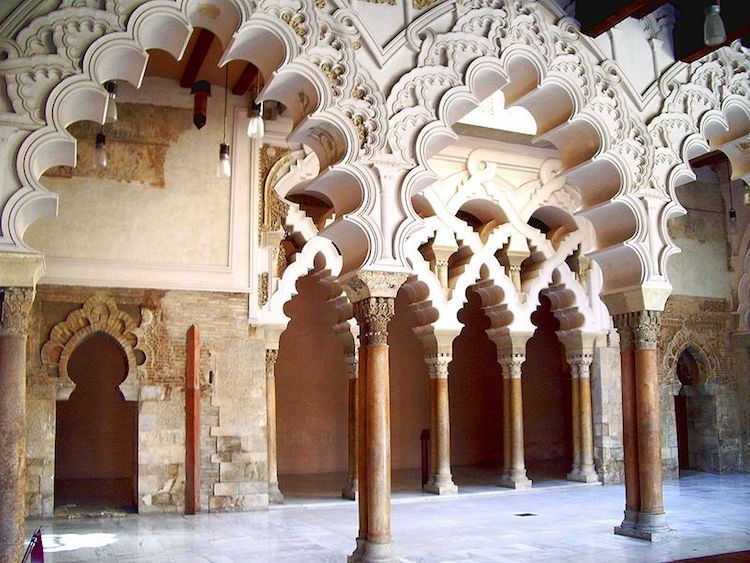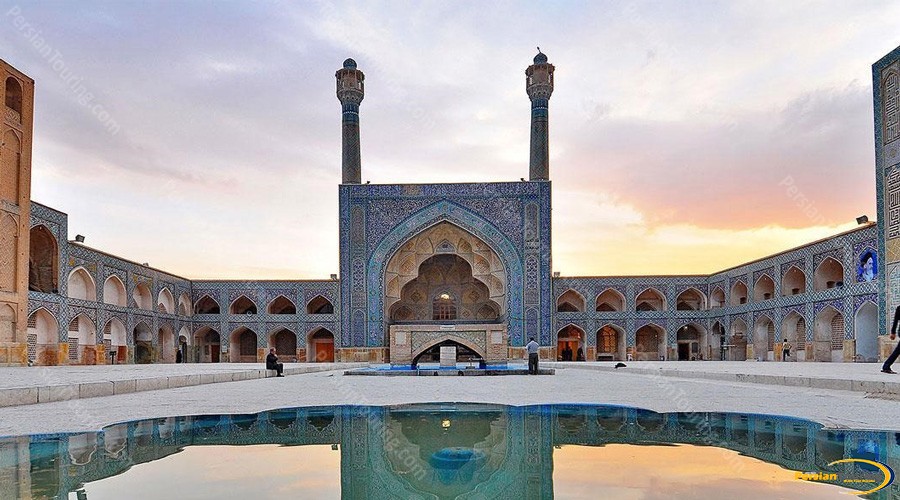Introduction
In this deep research, we will dive down into the world of Islamic architecture, finding the regional variations, key elements, and long-lasting effects it has on the architectural landscape. Islamic architecture has an inspiring and long history dating back centuries. Minarets and domes of mosques, geometric patterns, astonishing buildings, and innovative architecture all show the craft and creativity of Muslim architects and the perfect command they have of their skills.
Historical Advancement of Islamic Architecture

First Islamic Influences
Islamic architecture was greatly inspired by pre-Islamic Persia, Byzantium, and Arabia during their developing years. Islam began to spread early in the 7th century in the Arabian Peninsula, Islamic architecture roots can also be found in the same century.
Islamic architecture design creativity can be seen in the early constructed mosques like The Umayyad mosque in Damascus, and the Prophet Muhammad (PBUH) mosque in Medina, The designs and craftsmanship were simple and plain, with flat roofs, and plain facades. The designs show simplicity and culture. These crafts were the foundation of Islamic architecture which was to gain appreciation and popularity in the coming times.
Early Roots of Islamic Architecture
Tribular Traditions

The pre-Islamic influence before the rise of Islam was taken and adopted from the Arabian Peninsula which was a land of diverse tribal cultures, each with its own architectural practices. Early Islamic architecture took inspiration from a unique blend of these tribal traditions, that resonates to this day.
Harvest And Use The Water Efficiently

Islamic architects discovered and created genius ways to deal with the harsh climate of deserts because the Arabian desert weather and environment were a challenge on their own. Islamic architects laid the foundation for sustainable architectural practices in Islamic regions, and their inventions like the wind-catching towers and the passive cooling techniques made that possible.
Civil Engineering

The Forgotten Marvel Islamic architects excelled in hydraulic engineering, creating elaborate systems of fountains, canals, and gardens that not only beautified their surroundings but also served practical purposes, such as providing water for ablutions and irrigation.
The Golden Era of Islamic Architecture

The golden era, which spanned from the 7th to the 13th centuries, was the most extraordinary period in Islamic architectural history. This period beholds the construction of the most iconic Islamic architecture, like the great mosque of Cordoba in Spain and the Dome of the Rock in Jerusalem, The structure consists of a gilded wooden dome sitting atop an octagonal base. Inside, two ambulatories circle around a patch of exposed rock. The interior is richly decorated with marble, mosaics, and metal plaques Another remarkable feature of the mosque is the hypostyle hall consisting of approximately 850 columns made of porphyry, jasper, and marble supporting two-tier horseshoe arches.
Key Aspects
Islamic architecture is specified by some particular features that make it different from other architectural designs and styles.
Architectural Elements Beyond the Obvious
Acoustics in Islamic Architecture

The design of mosques and other Islamic buildings often incorporates acoustic principles that enhance the spiritual experience. The careful arrangement of columns, domes, and surfaces can create natural amplification, ensuring that the call to prayer and sermons is heard clearly by all worshipers.
Muqarnas

The Marvel of Three-Dimensional Design Muqarnas, a mesmerizing three-dimensional geometric design, is a hallmark of Islamic architecture. Delving deeper into its history and significance unveils its role in structural support and artistic expression of the divine order.
Calligraphy and Quranic Inscriptions

Islamic architecture design and styles include complex and complicated Quranic verses and calligraphy as decorative factors. It is not only visually appealing but also touches people’s hearts because of its deep spiritual relevance.
Geometric Patterns

Islamic geometric, precisely crafted patterns are not only visually appealing but also show and represent the infinite creation of Allah. These geometric patterns contain designs such as those on the ceilings, adorn walls, arabesques, and floors of many Islamic buildings
The Use of Light

Light plays a significant role in Islamic architecture. It symbolizes the presence of Allah and is often filtered through intricate stained glass windows or latticework. The interplay of light and shadow creates a serene and contemplative atmosphere within mosques.
Use of Arches

The use of horseshoes and pointed arches is favored by Islamic architecture. The designs both provide a sense of glory and structural stability at the same time.
Minarets

Minarets are not made just for visual landmarking in urban scenery, they are a defining feature of mosques. These tall towers were created for the purpose of being used for the call to prayer, or Adhan.
Domes

The domes created by Islamic architects are large in size and surely give a glimpse of majesticness in their designs. The most famous example is the iconic dome of Hagia Sophia in Istanbul, Turkey. To this date, it inspires and motivates architects around the globe
Courtyards and Gardens

Lush gardens and central courtyards are central features in Islamic architecture, crafting communal gatherings and spaces for reflection. Many mosques feature central courtyards and gardens. These spaces are not only aesthetically pleasing but also serve practical purposes. They provide ventilation and a place for worshipers to cool off in hot climates. Gardens also evoke the image of paradise described in the Quran.
Regional Differences
Islamic architecture is not fixed or crafted in the same design or pattern, it differs from region to region, showing historical and local cultural significance.
Persian Islamic Architecture

Nasir al Mulk Mosque in Shiraz, Iran, is a great example of Persian Islamic architecture known for its complex and difficult design, its floral motifs, and its marvelous stained glass windows. Persian Islamic architecture’s tile cutting, design, and use of blue ceramic tiles showcase a marvel in themselves.
Mughal Architecture in India

Known for its great white marble design and glorious gardens, The Taj Mahal, one of the seven wonders of the world and a UNESCO-declared world heritage site, is a shining example of Mughal architecture.
Moorish Architecture in Spain

The Alhambra in Granada is a great example of Moorish architecture. It focuses on the complex plaster and cement usage for crafting and lush gardens. The courtyards and rooms of the Alhambra are exquisitely decorated with colored tiles, carved stucco, carved wood, and calligraphy. Some of the most remarkable ornamental features are the intricately carved geometric stalactite designs (a recurring pattern in Islamic architecture called muqarnas in Arabic) that adorn the halls surrounding the Court of the Lions.
The Friday Mosque, Isfahan

Located at the center of Esfahan—a city full of architectural treasures—is the sprawling Friday Mosque. This mosque has stood on the site since the 8th century, but the oldest elements of the current structure are two domes built during the Seljuk dynasty, which ruled parts of Iran in the 11th century. Rectangular courtyard adjoins on each side by an iwan—a type of hall that opens into a tall arch on one side. The four-iwan design, which first appeared in Esfahan, later became the norm for Iranian mosques.
Ottoman Architecture

The Great Ottoman Empire, known for its overwhelming power and the parts of continents they ruled over, was not just the only victory; they also contributed to architectural advancement, such as the Grand Sultan Ahmed Mosque, also known by the name Blue Mosque, standing tall as a symbol of their architectural progress. Ottoman architecture is marked by its magnificent and grand use of minarets and domes.
Sub-Saharan African Architecture

Islamic architecture also flourished in Sub-Saharan Africa, particularly in regions like Mali and Sudan. The Great Mosque of Djenné, with its unique sun-dried structure, is a great example of African Islamic architecture.
Islamic Architecture in Indonesian

The craft and skills of Muslim architects can be seen in Indonesian mosques, The mosques have multi-level roofs that are decorated with complicated and beautiful carvings that tell a story of architectural innovation and cultural blend.
West Africa

In West Africa, the structures are designed to withstand the rigid and tough climate of the Sahelian climate, West African Islamic architecture is unique on its own the mosques there are made with mud bricks which blend smoothly with the dry landscape.
Impact and influence on present-time

Islamic architecture to this date still surprises designers and architects around the world with its architectural skills and innovation as it still uses harmonious designs, geometric precision, and respect for natural elements. This makes Islamic architecture a source of Inspiration for contemporary architectural projects.
Not only in Muslim-majority countries but also in Western architecture we find characteristics and hints of Islamic architecture, the work incorporated in buildings and designs. These cross-cultural architectural practices have enriched landscapes giving a boom to buildings containing a mix of old and new designs together.
Spiritual Importance of Islamic Architecture
Islamic architecture is not just about how beautiful it looks. It also has a deep spiritual meaning. Mosques, the most iconic structures in Islamic architecture, are places where Muslims gather to pray and worship Allah. They are designed to make people feel connected to Allah and be humble in His presence. This is done through the use of simple geometric shapes, intricate patterns, and natural light. The lack of human figures in Islamic art and architecture is also a way to focus attention on Allah.
Mosque as a Symbol

The mosque’s design is based on Islamic beliefs. The call of the adhan from the minaret reminds Muslims to pray. The dome symbolizes the vault of heaven and the unity of Allah. The qibla wall, facing Mecca, orients the worshipers toward the holiest city in Islam.
Islamic Architecture Founded in Unexpected Places
Islamic architectural elements have blended with Western designs this fusion of Islamic architecture creates unique buildings that celebrate multiculturalism, even though they are not as well-known as European architecture. This gives rise to hybrid architectural designing and crafting.
Contemporary art meets Islamic architecture
Artists and architects, worldwide are drawing inspiration from Islamic geometric patterns and calligraphy to create breathtaking contemporary installations and buildings. This intersection of art and architecture pays homage to the enduring allure of Islamic design.
Artists and architects around the world are using Islamic geometric patterns and calligraphy as inspiration to make modern art and buildings. This gives rise to Islamic architecture and innovation, and this mix of art and architecture celebrates the lasting beauty of Islamic design.
Islamic Architecture in the Modern World

The historical and cultural importance of Islamic architecture is undeniable, it continues to adapt and evolve with the modern world. Architects today are facing the challenge of integrating traditional Islamic design principles with contemporary needs and technologies.
Modern Interpretations of Tradition
Sustaining Mosque Design

In this environmentally conscious age, architects are renovating and modernizing mosque designs to be more sustainable and maintain internal integrity. They’re using solar panels, rainwater harvesting, and green roofs in modern mosques, reducing their carbon footprint while honoring Islamic architectural ethics and principles.
Digital Comeback
Islamic architecture in virtual reality allows the digitization and virtual reconstruction of historical Islamic buildings. These digital recreations not only preserve architectural heritage but also provide a unique educational experience, allowing people to explore these structures from the comfort of their homes.
A Bridge between Past and Future

Many groups and schools are committed to protecting and sharing Islamic architectural heritage. These efforts and actions are crucial for making sure that the importance of this ageless art is known and valued by future generations so that they can embrace it and carry it forward.
Future of Islamic Architecture

Around the world, there’s a renewed interest in Islamic architecture. Architects, scholars, and communities are having a global conversation to rethink how Islamic architecture can influence cities and encourage cultural exchange.
Sustaining the Islamic Architecture

Sustainability is a current growing concern for architects around the globe and Islamic architecture provides valuable lessons and ethics in this regard. Traditional Islamic buildings are designed with natural cooling techniques, such as water features and wind towers These practices can help a lot in sustaining the design and structure.
Restoration and Preservation
Preserving and restoring historical Islamic architecture is extremely important. Organizations and experts are working tirelessly to safeguard and renovate iconic structures that have stood for centuries. These struggles make sure that upcoming generations can admire and embrace the beauty and history of Islamic architecture.
VERDICT
It doesn’t matter whether Islamic architecture is a historical showpiece or if it’s a modern wonder, Islamic architecture always fascinates and inspires the whole world. It displays everlasting beauty, innovation, and cultural significance rooted within Islamic civilization.
From Islamic architecture’s early ages to its golden era and the coming future, it has left a long-lasting impression in the architecture field. Its well-defined features, regional differences, and ongoing impact make it a topic of interest and admiration worldwide.
Islamic architecture continues to shape the city horizon and touch the hearts of people, who come across its wonders, it invites us all to appreciate the various designs, crafts, and innovations of Islamic architectural heritage. It reminds us of the deep connection between architecture, culture, and spirituality.
Its features, regional differences, and ongoing impact make it a topic of interest as it’s admired worldwide. Valuing it helps us understand its rich history, creative heritage, and legacy.

